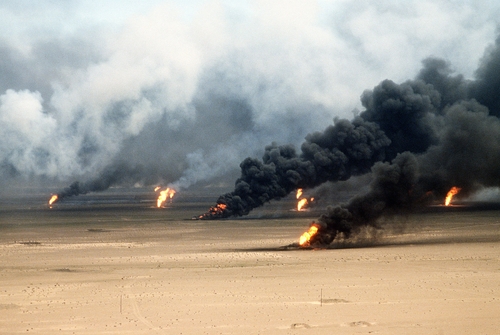
January 16th, 2016, marks the twenty-fifth anniversary of Operation Desert Storm, an unsettling milestone in the yet unfinished history of the United States bombing Iraq. We ought to ask, what lies in the wake of this now failed policy?
I remember that as a teenage boy the unfolding of Desert Storm transformed my adolescence. This was a new visual war that seemed to mimic the video games that had so infatuated me. As a member of the post-Vietnam generation, I would be signing up for the mandatory Selective Service in a few short years, at a time when most of my teachers had taught me to loath the draft that sent so many young men to their deaths in the 1960s and 1970s. That draft had disappeared, but America’s commitment to war had not. There had been U.S. incursions into Lebanon, Grenada, and Panama, but no Vietnam equivalent. The showdown with Iraq had the potential to be the Grunge era’s big war, one that would snowball into something larger in the coming years.
In 1991, America’s cause was a semi-noble one. The rescue of Kuwait had solid international backing. President George H.W. Bush’s approval number soared to 89%, only to tank the following election year, the result of his poor economic foresight. Things in Iraq turned sour thereafter. A drawn out bombing campaign, contradictory initiatives of economic sanctions and Oil-for-Food programs, horrendous bouts of financial corruption, and finally war and occupation cumulatively have done little but to make two generations of Iraqis and American veterans suffer immeasurably.
Under four administrations, Washington marched into the commitment to remove Saddam Hussein and promote an even grander idealistic vision of changing the country’s government structure, which was to alter the complexion of the region and favor the interests of the United States and Western allies. But this has remained a pipedream. Instead, America’s strategy in Iraq quickly atrophied in its postwar framework, which has metastasized into increased fragmentation of the region and new political coalitions of the most threatening kind.
Indeed American policy since 9/11 has been frustratingly myopic, and we seem perennially one step too late in grasping the broader implications of our actions. Not unlike the years of Vietnam, we again hear echoes of failed promises of American victory culture and ensuing disillusionment.
In looking forward, what is abundantly clear is that the United States and its allies cannot simply bomb their way out of Iraq and Syria. Whoever wins the presidency in 2016 will have a tall order in seeking a roadmap to stability that unites political and military calculus, which will undoubtedly depend on bringing new players to the diplomatic table. A clear military resolution is impossible to forecast because there is no consensus on what the political futures of Iraq and Syria ought to be. Throughout the region we are witnessing new forms of nationalism that draw from different ideological underpinnings, which are simultaneously political and religious. We are in an era of internal fractionalization that is challenging the domestic circuitry of several key countries—Iraq, Syria, Saudi Arabia, Turkey, Egypt, to name a few—and the makeover of their national identities, some minor, some major, which have yet to cohere and therefore frustrate traditional rituals of American diplomacy.
But the problems are not merely “over there.” The United States is undergoing its own period of national soul searching that has centered on a common language of fear and violence. The buzzwords of terrorism, refugees, gun rights, and Black Lives Matter all fundamentally coalesce around concerns of acceptable forms of violence, social exclusion, and bodily containment within our country’s democratic project. Anyone who has seen the Republican debates will attest that much of the current political discourse lacks compassion, which is fundamental for a healthy democracy. Fear of refugees and immigrants, and searing concern that the federal government will prevent us from bearing arms fill the chambers of internal security with defense and bans alone rather than empathy. It is not that militarization and screening have no place in these uncertain times, but the risk is that this strategy becomes singular without much-needed emotional and political complements.
The reality is that terrorism cannot destroy the United States, but it can weaken our values, which is more threatening to national well being. Abandoning democratic pluralism for reductive nativism and xenophobia is a surer way to bring down a country from within. Recent headlines suggest a resurgence of racist nationalism that apes earlier moments of U.S. history, those bygone signs urging “No Irish Need Apply” and the Chinese Exclusion Act of 1882. Today’s growing Islamophobia reveals a similar anger and fear as well as the struggle for Americans to secure appropriately the memory of 9/11 in our collective consciousness. That trauma is still present and is now being harnessed to justify oppressive public policies and social practices. Refugees and immigrants have fallen to toxic criminals rather than the huddled masses for whom Liberty has promised her sanctuary.
In glancing back over the last twenty-five years, it is crucial to consider alternative policies that can safely quarantine fear in order to reassert freedom for the needy as the hallmark of American democracy.